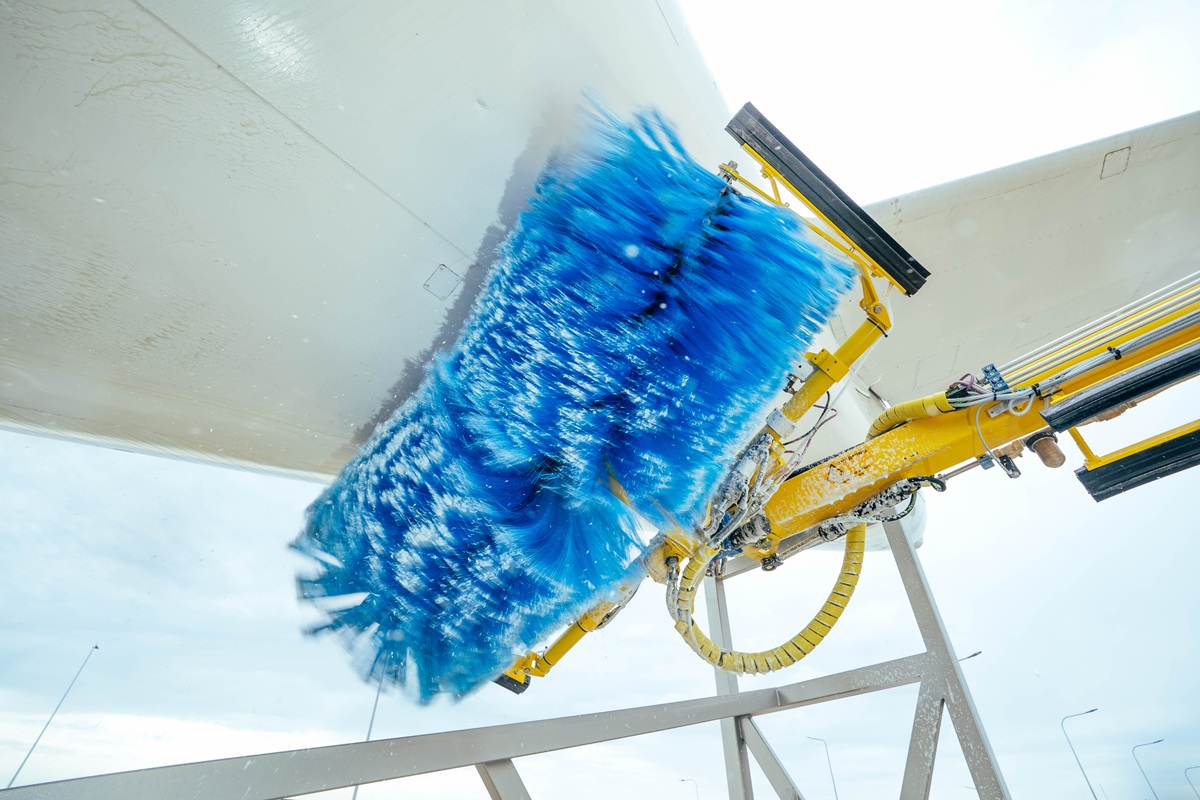 Every 2 to 6 months, a commercial aircraft undergoes a complete wash – an undertaking that can require up to 11,000 litres of water and several hours of work. When an aircraft is operated in harsh climates or frequently serves high-pollution routes, this timeframe shrinks to monthly. Interestingly, despite these regular cleaning cycles, one area is oftentimes overlooked, even though it is precisely that area that accumulates dirt the fastest – the belly of the aircraft.
Every 2 to 6 months, a commercial aircraft undergoes a complete wash – an undertaking that can require up to 11,000 litres of water and several hours of work. When an aircraft is operated in harsh climates or frequently serves high-pollution routes, this timeframe shrinks to monthly. Interestingly, despite these regular cleaning cycles, one area is oftentimes overlooked, even though it is precisely that area that accumulates dirt the fastest – the belly of the aircraft.
For airlines, this isn’t just a cosmetic concern. The buildup represents a complex mixture of hydraulic fluids, engine oils, runway residue, and atmospheric pollutants that can add weight, impact fuel efficiency, and mask critical inspection areas, says Veronika Andrianovaite, Chief Commercial Officer of Nordic Dino Robotics. According to her, this is why you need to pay close attention to the aircraft’s belly when cleaning.
The science of aircraft belly contamination
The aircraft belly becomes a collection point for contamination through a perfect storm of mechanical, environmental, and aerodynamic factors working together during every flight.
According to Andrianovaite, the primary culprits come from the aircraft itself.
“Hydraulic systems, operating at pressures exceeding 3,000 PSI, occasionally leak and create a fine mist during gear retraction,” she explains. “This hydraulic fluid spreads across the belly surface, creating a sticky base layer that attracts other contaminants. Engine oils and combustion byproducts flow backward along the fuselage, channeled directly onto the underside by airflow patterns.”
Ground operations compound the problem. During takeoff and landing, high-speed tires kick up runway contamination, such as rubber particles, asphalt residue, and accumulated oils, directly into the belly’s path. At cruise altitude, the situation doesn’t improve: atmospheric pollutants, industrial emissions, and even volcanic ash in certain flight paths adhere to the already-sticky surface.
“This accumulation follows specific patterns,” Andrianovaite notes. “Aerodynamic forces create specific concentration zones where vortices trap particles against the fuselage, while temperature variations during flight cycles essentially bake these deposits onto the aluminum, making them increasingly difficult to remove over time.”
The hidden costs of a dirty belly
While a grimy aircraft belly might seem like a purely aesthetic issue, the operational impacts translate directly into significant financial consequences for airlines operating on razor-thin margins.
The weight penalty alone is staggering. Recent research has shown that insect accumulation alone can lead to increases in fuel consumption of up to 1.1 to 4.4%. A comparative study involving two equally aged B747s flying between Amsterdam and New York revealed the real-world impact: the aircraft that had recently undergone cleaning saved half a ton of fuel, equivalent to 0.5%, on the same transatlantic route compared to its uncleaned counterpart.
“Multiply this across thousands of flights annually, and the accumulated grime on aircraft bellies represents millions in unnecessary fuel burn,” Andrianovaite adds. “When you consider that fuel consumption accounts for 25-30% of operating costs, that’s no small deal”.
Contamination layers pose another threat – hidden and thus difficult-to-notice corrosion. The hazardous mix of hydraulic fluids, salts, and other pollutants creates a corrosive environment that can eat into the fuselage. This can often go undetected because the thick contamination layer obscures visual inspections.
“Critical components like drain valves, sensors, and structural joints hide beneath layers of grime, potentially masking cracks, leaks, or other defects that would be immediately visible on a clean surface,” Andrianovaite explains.
Modern solutions for belly cleaning
The key to thoroughly cleaning every inch of an aircraft’s surface area lies in robotic arm reach and flexibility. While many automated washing systems do a decent job at cleaning the fuselage sides and top surfaces, the belly is harder to clean due to access issues.
“The varying heights between narrow-body and wide-body aircraft, combined with complex contours around landing gear bays, antennas, and drain masts, demand exceptional range of motion and precise positioning capabilities. A system that works perfectly for an A320’s belly might leave significant areas untouched on a 777,” Andrianovaite notes.
Advanced robotic cleaning systems solve this problem by providing ground staff with a way of getting under the aircraft at any angle. This flexibility is combined with rotating brushes that apply a mixture of water and detergent directly to the surface. The rotating action of the brush, combined with its controlled pressure against the aircraft's exterior, effectively removes contaminants while protecting the aluminum skin from damage.
Nordic Dino’s robotic systems follow this advanced approach, ensuring that the robotic arm can adjust to all surfaces, including the belly. This helps operators achieve unparalleled results, eliminating the need for manual touch-ups in hard-to-reach areas and minimizing any risk of damage to sensitive components.
